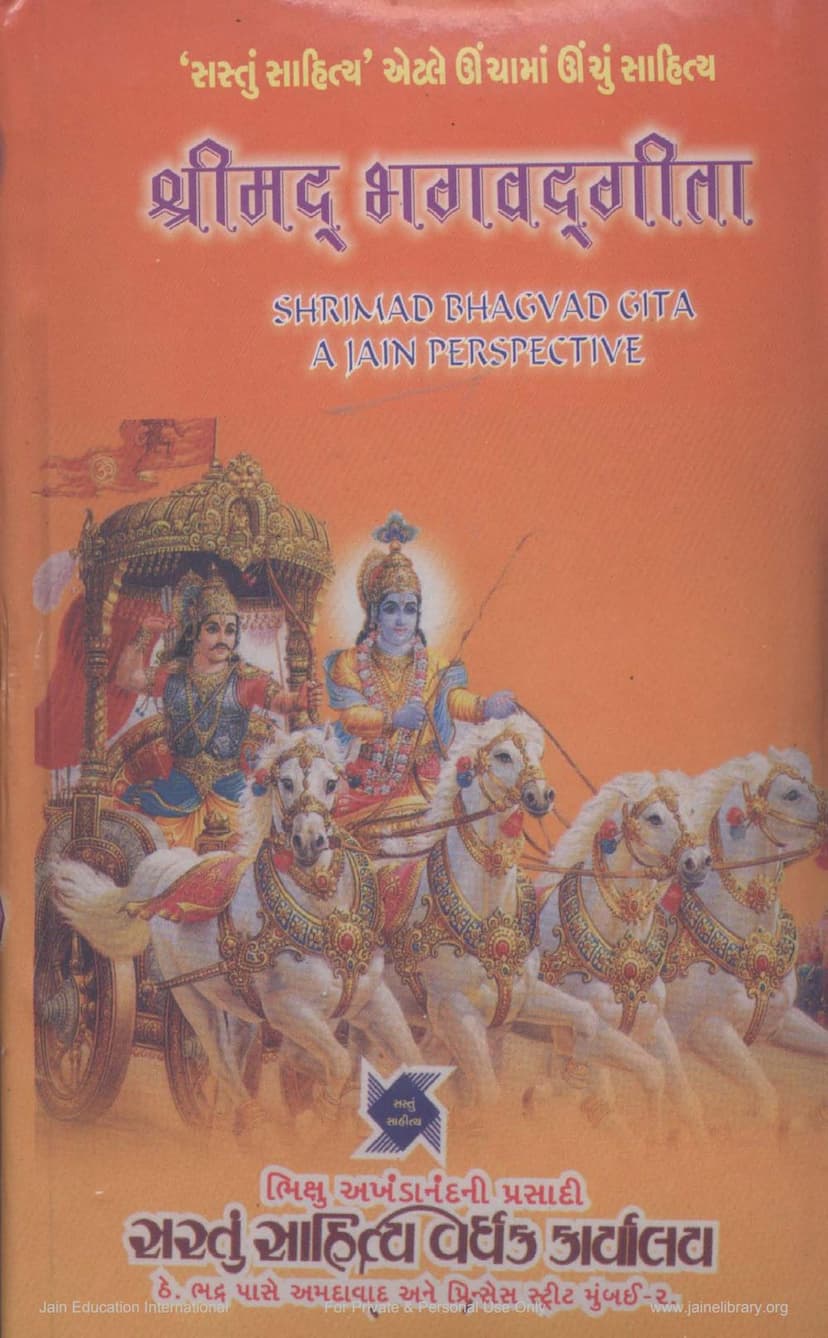Shrimad Bhagavad Gita
Added to library: September 2, 2025

Summary
The provided text is a detailed exposition of the Bhagavad Gita from a Jain perspective, authored by T. U. Mehta. Published by Sastu Sahitya Mudranalaya Trust, Ahmedabad, it aims to bridge the philosophical understanding between the Bhagavad Gita and Jainism.
Here's a comprehensive summary of the key themes and arguments presented in the text:
Core Argument: The central thesis is that the Bhagavad Gita, while often perceived as a purely Hindu scripture, contains universal teachings that resonate deeply with the core doctrines of Jainism. The author, a retired Chief Justice, seeks to highlight the synthesis and harmony found between the Gita's emphasis on knowledge, devotion, and action, and the Jain principles of Syadvad (relativity of truth) and Anekantvad (non-absolutism).
Jain Context and Historical Background:
- Shramana Tradition: The text begins by establishing the "Shramana tradition" as distinct from the Vedic tradition, encompassing Jainism and Buddhism. This tradition, originating with original inhabitants of the Indus Valley before Aryan migration, emphasized renunciation and austerity, contrasting with Vedic practices of Yajnas (sacrifices) and rituals.
- Aryan Influence: The migration of Aryans led to an intermingling of cultures. While Aryans brought their Vedas and Yajnas, they gradually absorbed indigenous cultures. This period saw the rise of the Upanishads, challenging Vedic rituals and incorporating Shramana ideas.
- Jain Tirthankaras and Influence: The text highlights the significant influence of Jain Tirthankaras like Rishabh Dev and Neminath on Indian thought. Neminath's connection to Lord Krishna is particularly noted, suggesting how Jain principles, especially non-violence (Ahimsa), influenced the reinterpretation of "sacrifice" (Yajna) in the Gita to mean actions for social good. The author posits that the Gita might predate Lord Mahavira and Buddha, possibly being composed in the early 6th century BC when Sankhya philosophy was dominant.
Key Jain Concepts and their Parallels in the Gita:
- Syadvad and Anekantvad: The Gita's ability to synthesize diverse philosophical trends is seen as a masterly expression of Syadvad, supporting the Jain doctrine that truth is multifaceted and relative to perspective. This universality makes the Gita a reference book for all aspirants.
- Self-Reliance and Self-Efficacy: Jainism's emphasis on the soul being its own cause and effect aligns with the Gita's message of self-effort and the soul's inherent potential. The concept of Tat Tvam Asi (Thou Art That) from the Upanishads is seen as resonating with this Jain belief.
- Jiva and Ajiva: The universe is explained as consisting of two fundamental elements: Jiva (soul, sentient) and Ajiva (non-sentient matter). This dualistic framework is considered similar to Sankhya's Purusha and Prakriti. The Jiva's pure state is omniscient and omnipotent, but its association with Ajiva (Karmas) blurs these qualities.
- Karma Theory and its Binding Nature: Jainism's detailed "Karma theory," explaining the process of bondage and liberation without an external divine controller, is presented as aligning with the Gita's teachings. The Jain principle of "action beginning at conception" (Kade Mane Kade - "action begins when thought of") is linked to the Gita's emphasis on performing actions without attachment to their fruits. This is crucial for avoiding karmic bondage.
- Bhava Karma (Intentional Action): Jainism emphasizes that the intention behind an action (Bhava) is more critical than the action itself in determining its karmic consequence. An action conceived without the intention to reap its fruits is considered akin to "no-action" and does not bind the soul. This aligns with the Gita's concept of Karma Yoga.
- Gunasthanas (Stages of Spiritual Development): The Gita's description of a Sthitaprajna (one of steady wisdom) and the path to spiritual progress is seen as mirroring the Jain concept of Gunasthanas, a ladder of 14 stages of spiritual development.
- Samata (Equanimity): The Jain emphasis on equanimity (Samata) as a key to spiritual attainment is paralleled by the Gita's descriptions of the Sthitaprajna, who remains undisturbed by pleasure or pain, gain or loss.
- Moksha (Liberation): The ultimate goal in both traditions is liberation from the cycle of birth and death. The Gita's description of the liberated soul (Siddha) not returning to the world aligns with Jain belief.
- Anekantvad and Syadvad: These Jain theories, advocating tolerance for diverse viewpoints and recognizing partial truth in every perspective, are seen as fundamental to the Gita's universal appeal and ability to harmonize conflicting philosophical trends.
- Rejection of Avatarvad: Jainism does not accept the concept of divine avatars descending to earth. The Gita's depiction of Krishna as an Avatar is interpreted symbolically, with "Krishna" representing the Supreme Divine Power or the Universal Soul rather than a human being.
- Symbolic Interpretation: The Mahabharata setting and the characters (Arjuna, Krishna, Kurukshetra, the war) are interpreted symbolically, representing the internal spiritual struggle of the individual soul against passions and ignorance, rather than a literal historical event.
- Yajna as Selfless Service: The concept of Yajna (sacrifice) in the Gita is interpreted in a Jain context as selfless service to humanity and the universe, rather than Vedic rituals. This aligns with the Jain emphasis on actions performed for the welfare of all beings.
- "Gunas" as Karmas: The Sankhya concept of Gunas (Satva, Rajas, Tamas) is closely linked to the Jain doctrine of Karmas, which determine the soul's destiny and personality traits. The goal is to transcend these Gunas or Karmas.
- Vitaraga: The Jain ideal of being free from passions (Vitaraga) is seen as equivalent to the Gita's descriptions of detached action and steady wisdom.
Structure and Approach: The book systematically analyzes the Bhagavad Gita chapter by chapter, drawing parallels between its teachings and Jain philosophy. It often quotes Jain scriptures and scholars to support its interpretations, offering a unique perspective on this widely revered text. The author's intention is to demonstrate that the Gita's teachings are not exclusive to any single religion but offer a path applicable to all spiritual seekers, especially those from the Jain tradition.